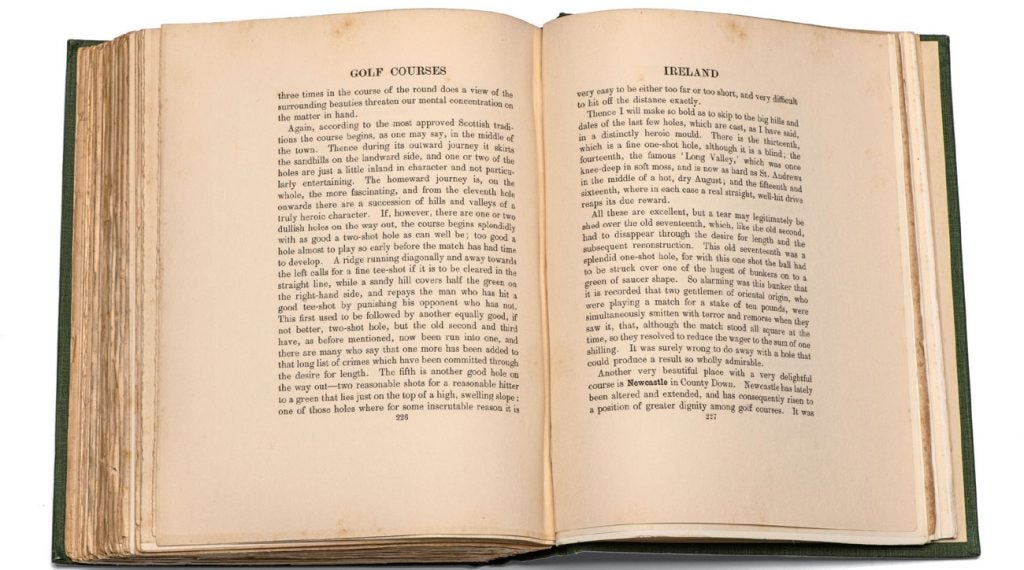 Rory makes ‘boring’ discovery, pro sends odd email, Hovland keeps tinkering | Monday Finish
Rory makes ‘boring’ discovery, pro sends odd email, Hovland keeps tinkering | Monday Finish
‘Delightful place to play’: The godfather of golf journalism on Royal Portrush

Bernard Darwin was the first writer ever to cover golf on a daily basis, and he’s widely thought to be the godfather of golf journalism. The grandson of the legendary naturalist could play a little, too. He was captain of his Cambridge University team in 1897, and went on to compete in 26 Amateur Championships in the UK. The man knew his way around a links, and poured that knowledge into his celebrated 1910 opus, “The Golf Courses of the British Isles.” Here is Darwin’s quaint, century-old riff on Royal Portrush, which he described as a “very delightful place to play.” Even the “lady golfers” would say that as a course rater and writer, he was a natural.

There is no country where the golfers are more keen or more hospitable than in Ireland, and the friendliness with which the inhabitants welcome their guests is only equalled by the earnestness with which they endeavor, and very often successfully, to beat them. It is a fine country for a golf holiday, and this fact is now so thoroughly appreciated that Englishmen and Scotsmen pour over to the Irish courses every summer, and more especially to the particular course on which the Irish Championship is being played for. At this meeting may be had fierce golf, tempered by a proper measure of cheerfulness, on which those who have played in it — sad to say I am not one of them — are never weary of descanting.
Portrush has many claims to fame, and amongst others is that of having produced a wonderful race of lady golfers. Considering how keen they are, and how good are the courses on which they play, the men of Ireland, albeit there have been some fine players amongst them, have not so far particularly distinguished themselves , but as regards ladies’ golf, Ireland was for a time supreme. Miss Rhona Adair and Miss May Hezlet (they are both married now, but the old names sound the more familiar) used to win the championship one after the other with monotonous regularity, and close on their heels flocked further and innumerable members of the Hezlet family.
Whether there are any subtle qualities about the course which naturally tend to the development of female champions I cannot say; I at least have not discovered them. At any rate it is a very delightful place in which to play golf, for persons of either sex. The air is so fine that the temptation to play three rounds is very hard to overcome, while I may quote, solely on the authority of a friend, this further testimonial to it, that it has the unique property of enabling one to drink a bottle of champagne every night and feel the better for it.

ADVERTISEMENT
Portrush stands on a rocky promontory that juts out into the Atlantic, and, if I may allude to such trivialities, the scenery of the coast is wonderfully striking. On the east are the White Rocks, tall limestone cliffs that lead to Dunluce Castle and the headlands of the Giant’s Causeway. On the west are the hills of Inishowen, beyond which lie Portsalon and Buncrana and the links of Donegal. It is, however, a remarkable thing that though golf courses are often in lovely places it frequently so happens that the beauties of the landscape are to be seen from anywhere except the course. Who, for instance, ever heard of a self-respecting sea-side course where one could get a view of the sea! One may hear it perhaps roaring or murmuring, according to its mood, beyond an interminable row of sandhills, but save with the artificial aid of a high tee one never dreams of seeing it. So it is at Portrush, in accordance with the best traditions, and only two or three times in the course of the round does a view of the surrounding beauties threaten our mental concentration on the matter in hand.
Again, according to the most approved Scottish traditions the course begins, as one may say, in the middle of the town. Thence during its outward journey it skirts the sandhills on the landward side, and one or two of the holes are just a little inland in character and not particularly entertaining. The homeward journey is, on the whole, the more fascinating, and from the eleventh hole onwards there are a succession of hills and valleys of a truly heroic character. If, however, there are one or two dullish holes on the way out, the course begins splendidly with as good a two-shot hole as can well be; too good a hole almost to play so early before the match has had time to develop. A ridge running diagonally and away towards the left calls for a fine tee-shot if it is to be cleared in the straight line, while a sandy hill covers half the green on the right-hand side, and repays the man who has hit a good tee-shot by punishing his opponent who has not. This first used to be followed by another equally good, if not better, two-shot hole, but the old second and third have, as before mentioned, now been run into one, and there are many who say that one more has been added to that long list of crimes which have been committed through the desire for length. The fifth is another good hole on the way out — two reasonable shots for a reasonable hitter to a green that lies just on the top of a high, swelling, slope: one of those holes where for some inscrutable reason it is very easy to be either too far or too short, and very difficult to hit off the distance exactly.
Thence I will make so bold as to skip to the big hills and dales of the last few holes, which are cast, as I have said, in a distinctly heroic mould. There is the thirteenth, which is a fine one-shot hole, although it is a blind; the fourteenth, the famous “Long Valley,” which was once knee-deep in soft moss, and is now as hard as St. Andrews in the middle of a hot, dry August; and the fifteenth and sixteenth, where in each case a real straight, well-hit drive reaps its due reward.

All these are excellent, but a tear may legitimately be shed over the old seventeenth, which, like the old second, had to disappear through the desire for length and the subsequent reconstruction. This old seventeenth was a splendid one-shot hole, for with this one shot the ball had to be struck over one of the hugest of bunkers on to a green of saucer shape. So alarming was this bunker that it is recorded that two gentlemen of oriental origin, who were playing a match for a stake of ten pounds, were simultaneously smitten with terror and remorse when they saw it, that, although the match stood all square at the time, so they resolved to reduce the wager to the sum of one shilling. It was surely wrong to do away with a hole that could produce a result so wholly admirable.
Excerpted from 1st Edition, Duckworth & Co., London (1910)
ADVERTISEMENT





